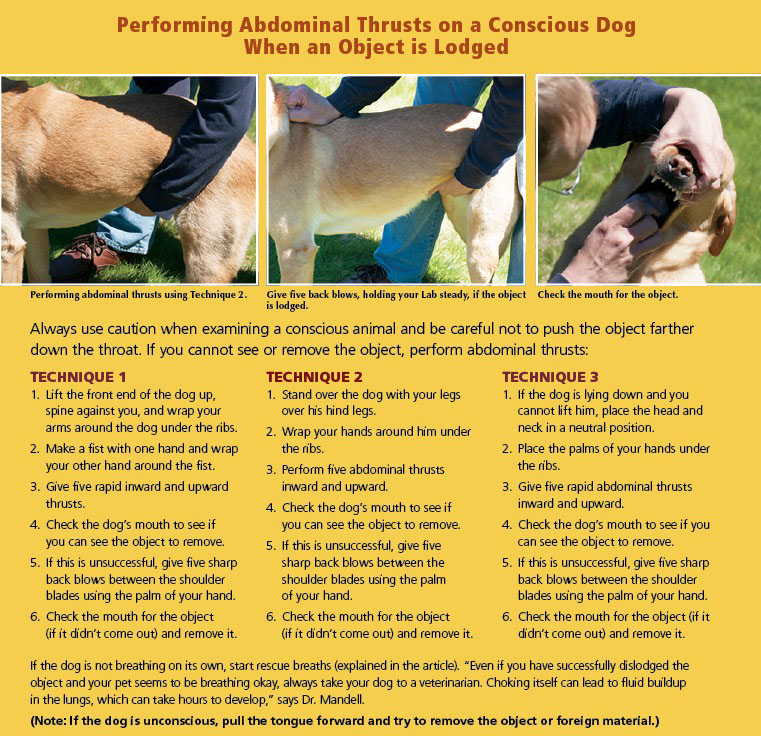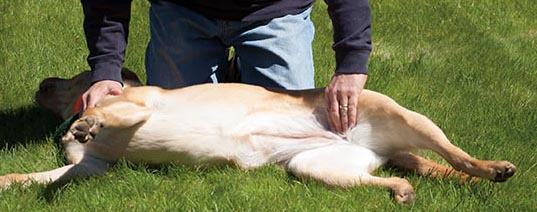First aid tip: To check for a pulse, the simpllest way is to position your Lab on
its side and place your hand in the area where the hind leg and lower abdomen meet.
The word “curious” comes to mind when describing a Labrador retriever. However, that curiosity, as endearing – and at times annoying – as it can be, can lead a Lab into trouble and a Lab owner frantically wondering what to do. Do you know what to do or what to look for if your Lab was shocked by a powerful fence? If she were to have trouble breathing because she swallowed something and it’s obstructing her airway? The Pet First Aid Course offered by the American Red Cross helps to better prepare dog owners who may find themselves in these and many other medical emergency situations – that may or may not be a result of Labrador curiosity. The preparation could save your Lab’s life.
Course Launch
Dr. Deborah Mandell is a Veterinary Medical Doctor, Diplomat, American College of Veterinary Emergency and Critical Care, and an American Red Cross Pet Care Advisor stationed at the Matthew J. Ryan Veterinary Hospital of the University of Pennsylvania. The first national course launched in 2008 and was developed for three reasons, says Dr. Mandell: to help owners learn how to be prepared for emergencies involving pets; to protect owners and their pets from further harm, injury, or suffering during emergencies; and to provide prompt, effective first aid care until veterinary care is available. From June 2011 to June 2012, over 5,000 people attended the Pet First Aid Course. Participants can focus on either a dog first aid or cat first aid session, or take both sessions.
More than teaching a set of skills, the American Red Cross Pet First Aid Course emphasizes pet owner responsibility. Pet owner responsibility is not limited to feeding your Lab twice a day or going for daily walks or making sure he gets to the vet each year. Owners are responsible for being aware of any changes to their Lab’s appearance or behavior, and to be proactive should an emergency occur. Every Lab is different – don’t we know it! – and owners need to be conscious of what is typical for their Lab. “Understanding basic pet owner responsibilities is very important in maintaining your pet’s health and welfare. We teach owners to learn what is normal for their dog because it is the best way to know when there is a problem,” explains Dr. Mandell.
 “Understanding how to take care of your dog to keep him healthy may prevent problems in the future. Your dog, and especially Labradors, just want to make you happy and will wag his tail no matter how bad he is feeling. We have to be able to recognize that there may be a problem despite this,” she continues. “Knowing [your dog’s] normal gum color, respiratory rate, heart/pulse rate, capillary refill time, temperature, attitude, activity, appetite, etcetera will be extremely important if you run into an emergency situation or are unsure if you have an emergency.”
“Understanding how to take care of your dog to keep him healthy may prevent problems in the future. Your dog, and especially Labradors, just want to make you happy and will wag his tail no matter how bad he is feeling. We have to be able to recognize that there may be a problem despite this,” she continues. “Knowing [your dog’s] normal gum color, respiratory rate, heart/pulse rate, capillary refill time, temperature, attitude, activity, appetite, etcetera will be extremely important if you run into an emergency situation or are unsure if you have an emergency.”
Mary Fischer, training specialist for the American Red Cross in the Greater Michigan Territory agrees: “It is important to know what is normal for your pet so you can recognize and respond to an emergency. One typical thing to note is the normal temperature for a dog is 100 to 102.5 degrees, which runs slightly higher than humans. If you are unsure about a situation, always call you veterinarian.”
What Pet Owners Learn
In recent years when seemingly larger and more intense natural disasters strike our shores and lands – Hurricane Katrina, Hurricane Sandy, the fatal string of tornadoes – pets may be as in need of medical care as the people they live with. Often caring for a pet during a disaster depends on the owner, so it is handy to have a first aid kit ready that includes supplies for your pets.
One of the most common questions during the course, in Fischer’s experience, has been what should I include? “Make a kit that includes the normal supplies as well as a leash, muzzle, and nail clippers and have a plan. You want to be prepared for what to do in a disaster situation as well. Put together a disaster kit for your family and include your pets. Add leashes, pet food, bowls, medical records, and a picture of your pet. It is important to have a plan for every member of your family including your pets. You can find the ‘Pets and Disaster Safety Checklist’ along with other helpful information at www.redcross.org to help you prepare,” says Fischer.

First aid tip: Perform chest compressions with one or two hands.
This is only one area of instruction in the Pet First Aid Course. What course of action do you take if your Lab has experienced an electrical shock, for instance? The important thing is being able to notice changes in your Lab’s physical state and overall behavior that may indicate an electrical shock. “Dogs, especially puppies, can be tempted to chew electrical cords,” says Dr. Mandell. “If they do this while no one is home, it can be hard to determine what happened. Signs include burns; tan, raw areas in the mouth, on the tongue, lips, gums; drooling; difficulty breathing; and lethargy. If you suspect that your pet may have chewed an electrical cord or has any of these signs, try to keep him calm and bring him to a veterinarian immediately. Electrocution can lead to fluid buildup in the lungs, which can be life threatening and may take hours to develop. Knowing [the] signs of shock – pale gums, prolonged capillary refill time, poor pulse, fast pulse, lethargy – can help you act quicker.”
If a dog has an obstruction in its throat and can’t breathe to the point where there is no pulse, or the dog goes into cardiac arrest for another reason, the course teaches how to perform CPR through demonstration and – depending on what equipment local chapters have available – the use of pet mannequins. “The guidelines and recommendations for CPR in dogs and cats have recently changed. These are
the first evidence-based guidelines that have been established based on an extensive evaluation of both the veterinary and human literature on CPR,” Dr. Mandell further explains. “Basically, the guidelines now follow CPR for humans in that chest compressions should start immediately if you suspect that your pet has arrested. You don’t have to make sure there is a heartbeat. If your pet is not breathing, and you are unsure if there is a heartbeat, start compressions at thirty compressions followed by two breaths for two-minute cycles.” Fischer further clarifies, “The dog [should be] laying down on its right ride. The rescuer kneels with the dog’s chest facing toward [them].
“If your pet is choking and stopped breathing, or is not breathing for another cause but does have a heartbeat, then follow the guidelines for rescue breathing. For Labradors, close the mouth and breathe into the nose. Watch to see if the chest rises. Give a breath, ten to twelve breaths per minute.” In both situations, pet owners should either be on their way or plan to make their way quickly to the vet. Dr. Mandell has had owners perform rescue breathing in a car on the way to the Matthew J. Ryan Veterinary Hospital for further treatment – and the dog recovers.
According to www.redcross.org, the course also teaches pet owners how to administer medicine, take a pulse, manage an urgent care situation, treat wounds, and how to care for eye, foot, and ear injuries.
The Education Continues at Home
When dog owners attend the class, they are able to learn techniques through demonstration and hands-on instruction, and they are able to ask questions of the instructors to start becoming familiar with performing emergency procedures. Participants also receive the Red Cross Dog First Aid Guide with DVD. “The DVD demonstrates how to manage a variety of urgent care situations. The guide goes through specific conditions and what you can do.”
Some of these conditions are lifelong health issues of the dog, conditions owners need to know how to treat if something abnormal occurs. “For instance, if your dog is a diabetic and is showing signs of too low blood sugar, rub molasses or corn syrup on the gums to try to increase the blood sugar,” explains Dr. Mandell. “Also, knowing which conditions your dogs’ breed is susceptible or prone to can help. For instance, we see laryngeal paralysis in Labradors, so if you notice that your dog starts having noisy breathing or loud breathing on inspiration, you would know to bring your dog to the veterinarian. Any information on a specific breed can be helpful, but know that any dog can get any condition.” All of this information and more is included in the guide, which is available to all dog owners at www.redcross.org.
Dr. Mandell encourages participants, once they complete the course, to practice on their dogs and come up with a plan in case of emergency. “All participants should go home, go through what is normal for their pet as far as gum color, heart rate, pulse rate, temperature, [and] write it down. They should fill out their emergency plan list of phone numbers and what they would do in an emergency or disaster [and] make sure they have all supplies needed. They should make sure all vaccinations are up to date.” Practicing CPR, choking, and other life-saving techniques on the dog will help make the motions familiar on the participant’s dog specifically – where to do chest compressions, the easiest way to do abdominal thrusts – which will make handling the emergency easier should they become necessary to perform.
The Pet First Aid Course is another way the American Red Cross helps better the lives of people, by giving pet owners the tools – as well as the knowledge – to take care of their beloved canine companions.![]()
Red Cross Pet First Aid course participants learn how to prevent and respond to emergencies until veterinary care is available. Go to www.redcross.org for information or to purchase the Dog First Aid Guide with DVD. Please note: The photos for this article were for demonstration purposes only. It’s recommended that you get further instruction on these techiques from a class or your veterinarian.



